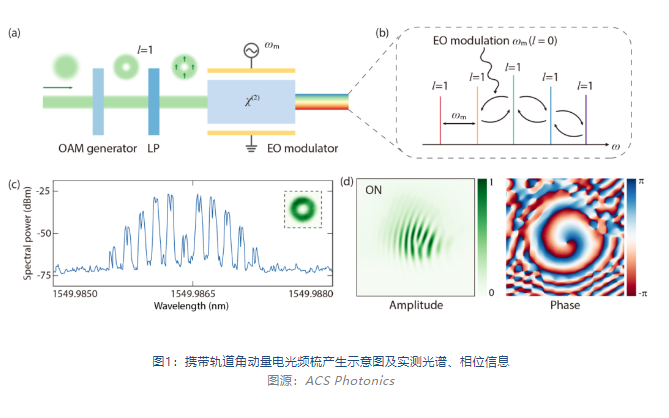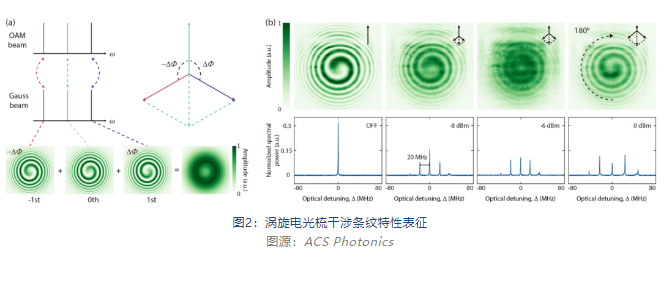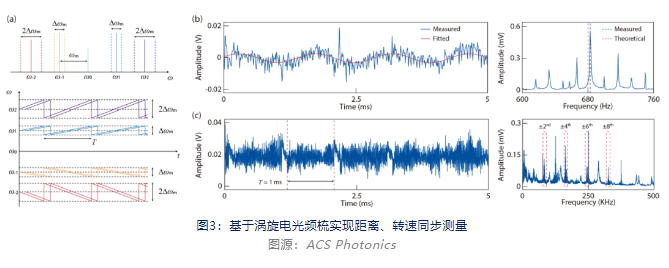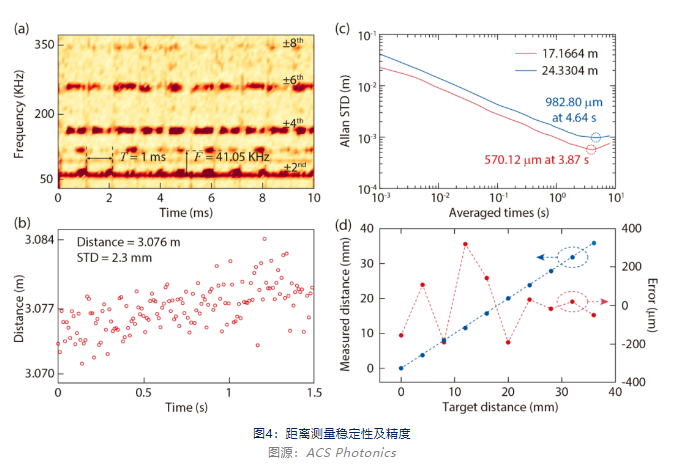01
2024
-
12
Electro-optic frequency comb carrying orbital angular momentum
Author:
Currently, there are mainly two approaches to generate optical frequency combs carrying orbital angular momentum.
-
One approach is to use spatial light modulators to spatially modulate the frequency comb source generated by mode-locked lasers. However, due to the influence of wavelength on spatial light modulators, the vortex optical frequency comb generated by this method cannot guarantee the purity of the vortex information for each comb tooth.
-
Another approach is based on an integrated photonics platform with third-order nonlinearity, utilizing continuous optical pumping of high-quality factor optical microcavities with angular grating structures to generate out-of-plane radiating vortex soliton optical combs. This method greatly reduces the size of the device while exploring the joint control of multidimensional complex spacetime optical fields, but the soliton comb in this scheme is limited to specific repetition frequencies and is constrained by out-of-plane radiation and waveguide microcavity coupling efficiency, resulting in relatively low energy utilization.
Recently, Tsinghua UniversityAssociate Professor Li Yang's research groupand collaborators proposed a scheme for generating electro-optic frequency combs carrying orbital angular momentum. By modulating vortex beams with lithium niobate phase modulators, they produced vortex electro-optic frequency combs with high purity, high conversion efficiency, and adjustable repetition frequency. Based on the rotational Doppler effect of vortex beams and the large modulation range of high-order sidebands of the electro-optic frequency comb, this research group achieved high-precision distance and rotational speed synchronous measurements for non-cooperative targets for the first time.
The results were published in ACS Photonics, titled 'Electro-Optic Frequency Comb Carrying Orbital Angular Momentum.' The completion units of this work are the Department of Precision Instruments at Tsinghua University and the School of Physics Science and Technology at Northwestern Polytechnical University. PhD student He Jinze and postdoctoral researcher Jia Xingyu from the Department of Precision Instruments at Tsinghua University are co-first authors of the paper, with corresponding authors being Associate Professor Li Yang from Tsinghua University, Associate Professor Wei Bingyan from Northwestern Polytechnical University, and Associate Professor Wu Guanhao from Tsinghua University.
Design concept and working principle
The scheme for generating electro-optic frequency combs carrying orbital angular momentum by the team is shown in Figure 1(a). The vortex beam in a linearly polarized state passes through a lithium niobate phase modulator, and the vortex beam satisfies the conservation of orbital angular momentum during the cascading nonlinear and frequency difference processes. Therefore, the output electro-optic frequency comb sidebands carry vortex information consistent with the pump, as shown in Figure 1(b). The spectral and phase information of the electro-optic frequency comb generated in the experiment is shown in Figure 1(c-d), verifying the vortex characteristics of the optical comb.

Vortex electro-optic frequency comb interference fringe characteristics
In the experiment, the research team explored the effects of modulation depth and unequal arm lengths on the interference fringes of the vortex electro-optic frequency comb. Due to the dispersion introduced by the wavelength differences between different order comb teeth, there is a certain phase difference between the interference fringes corresponding to different order comb teeth. Therefore, the overall fringe information can be viewed as the superposition of multiple vector fringe information, as shown in Figure 2(a). When the interference phase difference between the positive and negative first-order comb teeth and the pump exceeds π/2 and the intensity vector sum equals the pump fringe, the overall interference fringe will disappear, as shown in Figure 2(b). When the interference phase difference exceeds π/2 and the intensity vector sum is greater than the pump fringe, the overall interference fringe will flip.

Synchronous measurement of distance and rotational speed for non-cooperative targets
Due to the poor repetition frequency adjustment capability of traditional vortex optical frequency combs, their potential distance measurement methods are limited to resolving phase information from time-domain measurement signals to obtain distance information. When facing real-time jitter from non-cooperative targets, significant random time-varying phase noise will limit the precise resolution of distance information. As shown in Figure 3(a), the electro-optic frequency comb generated by the research team has a wide range of adjustable repetition frequency, and the frequency modulation range increases with the order of the comb teeth. This characteristic can improve the resolution and accuracy of distance measurement based on frequency-modulated continuous wave methods. Additionally, vortex beams possess a rotational Doppler effect that is independent of wavelength, allowing the electro-optic frequency comb generated by the research team to achieve high-precision distance and rotational speed synchronous measurements for non-cooperative targets.

To improve the signal-to-noise ratio of the collected data and separate the distance and rotational speed information of non-cooperative targets, the research team used two photodetectors to synchronously measure the time-domain signals of scattered stray light from the rough object under test (as shown in Figures 3b and 3c). By performing Fourier transform analysis on the time-domain signals, they could directly resolve the rotational speed information of the object under test (right side of Figure 3b) and the beat frequency spectrum information corresponding to different order comb teeth of the continuously frequency-modulated electro-optic frequency comb (right side of Figure 3c).
The results show that the measurement error for the rotational speed of non-cooperative targets is less than 0.44%. The distance information of the object under test, calculated using the beat frequency spectrum information corresponding to high-order comb teeth, shows that for an average distance of 3.076 m, the standard deviation of 150 measurements within a measurement time of 1.5s is 2.3 mm, as shown in Figures 4(a-b). Figure 4(c) shows that at a measurement distance of 17.1664 m and an average measurement time of 3.87 s, the achievable Allan variance is 570.12 μm. Figure 4(d) demonstrates that the measurement residuals obtained while continuously changing the distance of the object under test can be reduced to 152.52 μm. The above results demonstrate the stability and accuracy of distance measurement for non-cooperative targets based on vortex electro-optic frequency combs.
Summary and outlook
The research team proposed a generation scheme for an optical frequency comb carrying orbital angular momentum. This vortex optical frequency comb has advantages of high purity, high conversion efficiency, and adjustable repetition frequency. Based on the vortex optical frequency comb, the research group achieved high-precision distance and rotational speed synchronization measurements for non-cooperative targets for the first time. In the future, this work can be transferred to integrated photonic platforms, utilizing integrated optical waveguide modulators for higher modulation efficiency and larger modulation bandwidth, to produce optical frequency comb sources with a wider spectral range and greater repetition frequency modulation range. Meanwhile, this physical process can also be extended to the generation of arbitrary vector light field optical frequency combs.

Summary and outlook
The research team proposed a generation scheme for an optical frequency comb carrying orbital angular momentum. This vortex optical frequency comb has advantages of high purity, high conversion efficiency, and adjustable repetition frequency. Based on the vortex optical frequency comb, the research group achieved high-precision distance and rotational speed synchronization measurements for non-cooperative targets for the first time. In the future, this work can be transferred to integrated photonic platforms, utilizing integrated optical waveguide modulators for higher modulation efficiency and larger modulation bandwidth, to produce optical frequency comb sources with a wider spectral range and greater repetition frequency modulation range. Meanwhile, this physical process can also be extended to the generation of arbitrary vector light field optical frequency combs.
LATEST NEWS
2025-01-09
Design and Development of Full-Spectrum Photodetectors
In recent years, the booming optoelectronic industry has changed the world and extended into many aspects of life. Among them, photodetectors (PDs) with a wide response bandwidth from deep ultraviolet to visible to near-infrared serve as important optoelectronic components and play a key role in daily life.
2025-01-08
Black arsenene multi-spectral integrated field-effect transistors, aiding high-resolution imaging and enhanced secure communication.
With the development of modern communication technology, the demand for broadband, room-temperature infrared, and terahertz (THz) detectors has rapidly increased. These detectors play a crucial role in fields such as telecommunications, security inspection, non-destructive testing, and medical diagnostics. However, existing optical detectors face challenges such as high intrinsic dark current and the need for low-temperature cooling, which limit their efficiency in detecting low-energy photons. Particularly in the terahertz band, the photon energy is insufficient to excite electron transitions from the valence band maximum (VBM) to the conduction band minimum (CBM), making effective optoelectronic conversion difficult. Therefore, researchers have been seeking ultra-broadband detectors that can operate at room temperature and respond to wavelengths ranging from visible light to the terahertz band.
2024-12-30
Laser-based tiered neurons achieve high-speed reservoir computing.
Neuromorphic computing is a computational paradigm that simulates the functions and architecture of biological neurons. A single biological neuron is a powerful computational unit with information processing capabilities, information transmission abilities, and memory functions. Therefore, it is crucial to design a photonic neuromorphic processor that can truly emulate the powerful computational functions of biological neurons.
2025-01-01
Design and Development of Full-Spectrum Photodetectors
In recent years, the rapidly growing optoelectronic industry has changed the world and extended into many aspects of life. Among them, photodetectors (PDs) with a wide spectral response from deep ultraviolet to visible to near-infrared serve as important optoelectronic components and play a key role in daily life.
2024-12-31
High-sensitivity quantum dot photodetectors from deep ultraviolet to near-infrared
In recent years, the rapidly growing optoelectronic industry has changed the world and extended into many aspects of life. Among them, photodetectors (PD) with deep ultraviolet-visible-near infrared full spectrum detection response serve as important optoelectronic components, playing a key role in daily life.

